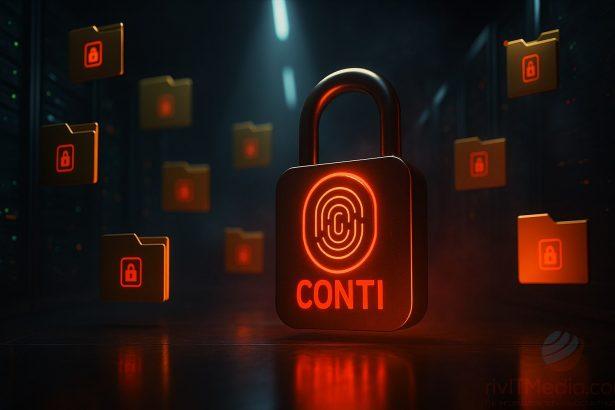A major Irish hospital network ground to a halt in May 2021 when Conti ransomware struck, encrypting critical patient records and halting outpatient services overnight. Across Europe, government ministries faced similar chaos, and in April 2022 the Costa Rican state declared a national cyber emergency after Conti demanded a $10 million ransom for stolen tax data. This high-velocity malware leverages both encryption and exfiltration to coerce victims into paying—and it evolves faster than most defenses can keep up.
Threat Overview
Conti is a ransomware-as-a-service (RaaS) operation first deployed in December 2019 by the Russia-based “Wizard Spider” group. Once inside a Windows environment, it encrypts files using AES-256 (with per-file keys) and RSA-4096, spreads via SMB shares, and purges backups to prevent recovery without paying. In double-extortion fashion, it also steals data and threatens publication on its leak site. All supported Windows versions are at risk, and affiliates deploy it globally against healthcare, critical infrastructure, and large enterprises.
In-Depth Analysis
Infection Vector
Conti affiliates gain entry via phishing emails carrying malicious macros, BazarLoader or TrickBot installers, or by exploiting open SMB (445) ports. Unpatched Windows servers and weak RDP credentials remain favorite entry points. Once inside, they deploy the ransomware binary and often additional backdoors.
Behavioral Profile
- Initial foothold: Macro-enabled document or exploit payload installs a loader.
- Lateral movement: Tools like Cobalt Strike and SMB scans spread access.
- Preparation: Disables security services (VSS admin, Defender), deletes shadow copies, and terminates backup processes.
- Encryption: Launches multi-threaded AES-256 encryption (up to 32 threads per file), appends unique extensions, and plants
CONTI_README.txtin each directory. - Exfiltration & extortion: Contacts command-and-control to upload stolen data, then demands ransom on a Tor-only site.
Risk Assessment
Conti ranks among the most damaging ransomware strains ever documented, with affiliates extorting over $150 million from 1,000+ victims by early 2022. Healthcare and government sectors suffer the greatest operational impact—emergency care diverted, public services suspended, trade stalled—and secondary infections often follow, compounding recovery costs.
Artifact Text
CONTI_README.txt
Your system is LOCKED.
Write us at the emails:
mantiticvi1976@protonmail.com
fahydremu1981@protonmail.com
DO NOT TRY to decrypt files using other software.
If you do not pay, we will publish all private data on http://conti.news/
Manual Ransomware Removal Process
Important: Manual removal is recommended only for experienced users, as incorrect actions can lead to data loss or incomplete removal of the ransomware. If unsure, consider the SpyHunter Removal Method for a guided, automated solution.
Step 1: Disconnect from the Internet
- Immediately disable Wi-Fi or unplug the Ethernet cable to prevent the ransomware from communicating with remote servers.
- This can prevent additional encryption or further infections.
Step 2: Boot into Safe Mode
For Windows Users
- Windows 10/11:
- Press Windows + R, type
msconfig, and press Enter. - Under the Boot tab, select Safe boot and check Network.
- Click Apply, then OK, and restart your PC.
- Press Windows + R, type
- Windows 7/8:
- Restart your PC and press F8 repeatedly before Windows starts.
- Select Safe Mode with Networking and press Enter.
For Mac Users
- Restart your Mac and hold the Shift key immediately after the startup chime.
- Release the key when the Apple logo appears.
- Your Mac will boot in Safe Mode.
Step 3: Identify and Terminate Malicious Processes
Windows
- Open Task Manager by pressing Ctrl + Shift + Esc.
- Look for unusual processes consuming high CPU or memory.
- Right-click on the suspicious process and select End Task.
Mac
- Open Activity Monitor (Finder > Applications > Utilities > Activity Monitor).
- Look for unknown or high-resource-consuming processes.
- Select the suspicious process and click Force Quit.
Step 4: Delete Ransomware Files
Windows
- Open File Explorer and navigate to:
C:\Users\[Your Username]\AppData\LocalC:\Users\[Your Username]\AppData\RoamingC:\Windows\System32
- Identify and delete suspicious files (randomly named or recently modified items).
- Clear temporary files:
- Press Windows + R, type
%temp%, and hit Enter. - Delete all files in the Temp folder.
- Press Windows + R, type
Mac
- Open Finder and select Go > Go to Folder.
- Type
~/Library/Application Supportand check for unfamiliar files or folders. - Remove unknown
.plistfiles from~/Library/LaunchAgents.
Step 5: Remove Ransomware Entries from Registry or System Settings
Windows
- Press Windows + R, type
regedit, and hit Enter. - Navigate to:
HKEY_CURRENT_USER\SoftwareHKEY_LOCAL_MACHINE\Software
- Identify and delete ransomware-related registry entries.
Mac
- Open System Preferences > Users & Groups.
- Select the Login Items tab and remove any unknown startup programs.
- Check
~/Library/Preferencesfor malicious settings.
Step 6: Restore System Using a Backup or Restore Point
Windows
- Press Windows + R, type
rstrui, and press Enter. - Choose a restore point from before the infection and proceed.
Mac
- Restart your Mac and enter macOS Utilities by holding Command + R.
- Select Restore from Time Machine Backup and restore a safe backup.
Step 7: Attempt to Decrypt Files
- Check No More Ransom (www.nomoreransom.org) for available decryption tools.
- If unavailable, restore files from backups.
Automated Ransomware Removal with SpyHunter
If manual removal is too complex or risky, SpyHunter offers a safer, automated method for detecting and removing ransomware.
Step 1: Download SpyHunter
- Get SpyHunter from the official Enigma Software website.
Step 2: Install SpyHunter
- Open the downloaded file (
SpyHunter-Installer.exeor.dmgfor Mac users). - Follow the installation prompts.
- Launch SpyHunter upon completion.
Step 3: Run a Full System Scan
- Click Start Scan Now to detect malware and ransomware.
- Wait for the scan to complete and review detected threats.
Step 4: Remove Detected Ransomware
- Click Fix Threats to remove identified ransomware components.
- SpyHunter will clean your system automatically.
Step 5: SpyHunter’s Custom Malware HelpDesk
- If ransomware persists, use SpyHunter’s Malware HelpDesk for custom malware fixes.
Step 6: Restore Files
- Use backups stored on external drives or cloud storage.
- If no backup is available, check No More Ransom for decryption tools.
Preventing Future Ransomware Attacks
- Keep backups: Use cloud storage or an external hard drive.
- Install a reliable security tool: SpyHunter offers real-time protection against malware.
- Enable Windows Defender or Mac security features for additional protection.
- Avoid phishing emails and unknown attachments.
- Regularly update Windows, macOS, and installed applications.
Conclusion
Conti’s blend of lightning-fast encryption, data theft, and a professionalized criminal infrastructure makes it exceptionally dangerous. Early detection—via anomaly monitoring, segmented backups, and strict MFA—remains the only reliable defense. Once encrypted, recovery without paying is near-impossible; restoring from air-gapped backups and engaging incident response swiftly are paramount.




